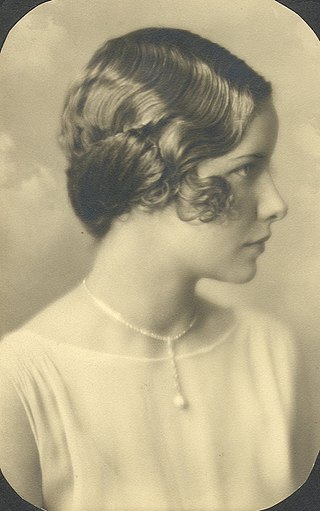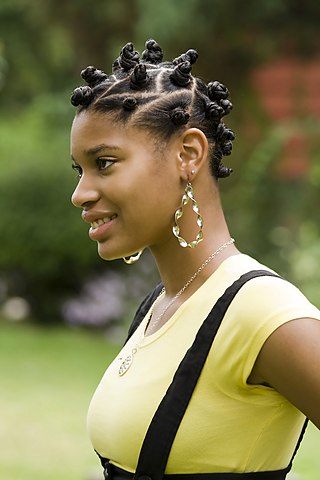
A hairstyle, hairdo, haircut, or coiffure refers to the styling of hair, usually on the human head but sometimes on the face or body. The fashioning of hair can be considered an aspect of personal grooming, fashion, and cosmetics, although practical, cultural, and popular considerations also influence some hairstyles.

Silica gel is an amorphous and porous form of silicon dioxide (silica), consisting of an irregular tridimensional framework of alternating silicon and oxygen atoms with nanometer-scale voids and pores. The voids may contain water or some other liquids, or may be filled by gas or vacuum. In the last case, the material is properly called silica xerogel.

A finger wave is a method of setting hair into waves (curls) that was popular in the 1920s and early 1930s and again in the late 1990s in North America and Europe. Silver screen actresses such as Josephine Baker and Esther Phillips are credited with the original popularity of finger waves. In their return in the 1990s, the style was popularized by pop stars like Madonna, and hip-hop stars of the time, such as Missy Elliott. The popularity of finger waves in the 1990s was aided by a movement toward shorter, more natural hair in the African-American community. This also was a common hairstyle worn by slaves back in 1802 through generations to 1889 and only began to take effect of popularity when Bette Davis danced on Sugar be mine live television.

Hair conditioner is a hair care cosmetic product used to improve the feel, texture, appearance and manageability of hair. Its main purpose is to reduce friction between strands of hair to allow smoother brushing or combing, which might otherwise cause damage to the scalp. Various other benefits are often advertised, such as hair repair, strengthening, or a reduction in split ends.

Hair mousse, also referred to as styling foam, is a hairstyling product to protect, control, and style hair. "Mousse" originates from a French term meaning foam. Hair mousse originated in France and was brought to the North American retail market by L'Oreal in the 1980s.

A hair iron or hair tong is a tool used to change the arrangement of the hair using heat. There are three general kinds: curling irons, used to make the hair curly, straightening irons, commonly called straighteners or flat irons, used to straighten the hair, and crimping irons, used to create crimps of the desired size in the hair.

Pomade is a greasy, waxy, or water-based substance that is used to style hair. It generally gives the user's hair a shiny, slick appearance. It lasts longer than most hair-care products, and often requires repeated washes for complete removal. The pomades of the 18th and 19th centuries consisted mainly of bear fat or lard. Lanolin, beeswax and petroleum jelly have been used extensively in modern pomades. The hold of pomades makes sculptured hairstyles such as the pompadour waves (hairstyle) possible.
A relaxer is a type of lotion or cream generally used by people with tight curls or very curly hair which makes hair easier to straighten by chemically "relaxing" the natural curls. The active agent is usually a strong alkali, although some formulations are based on ammonium thioglycolate or formaldehyde.
Artificial hair integrations, more commonly known as hair extensions, hair weaves, and fake hair add length and fullness to human hair. Hair extensions are usually clipped, glued, or sewn on natural hair by incorporating additional human or synthetic hair. These methods include tape-in extensions, clip-in or clip-on extensions, micro/nano rings, fusion method, weaving method, and wigs.

Hair care or haircare is an overall term for hygiene and cosmetology involving the hair which grows from the human scalp, and to a lesser extent facial, pubic and other body hair. Hair care routines differ according to an individual's culture and the physical characteristics of one's hair. Hair may be colored, trimmed, shaved, plucked or otherwise removed with treatments such as waxing, sugaring and threading. Hair care services are offered in salons, barbershops and day spas, and products are available commercially for home use. Laser hair removal and electrolysis are also available, though these are provided by licensed professionals in medical offices or speciality spas.

Hair straightening is a hair styling technique used since the 1890s involving the flattening and straightening of hair in order to give it a smooth, streamlined, and sleek appearance. It became very popular during the 1950s among black males and females of all races. It is accomplished using a hair iron or hot comb, chemical relaxers, Japanese hair straightening, Brazilian hair straightening, or roller set/blowdryer styling. In addition, some shampoos, conditioners, and hair gels can help to make hair temporarily straight.
A digital perm is a perm that uses hot rods with the temperature regulated by a machine with a digital display, hence the name. The process is otherwise similar to that of a traditional perm. The name "digital perm" is trademarked by a Japanese company, Paimore Co. Hairstylists usually call it a "hot perm."
A xerophyte is a species of plant that has adaptations to survive in an environment with little liquid water. Examples of xerophytes include cacti, pineapple and some gymnosperm plants. The morphology and physiology of xerophytes are adapted to conserve water during dry periods. Some species called resurrection plants can survive long periods of extreme dryness or desiccation of their tissues, during which their metabolic activity may effectively shut down. Plants with such morphological and physiological adaptations are said to be xeromorphic. Xerophytes such as cacti are capable of withstanding extended periods of dry conditions as they have deep-spreading roots and capacity to store water. Their waxy, thorny leaves prevent loss of moisture.

Waves are a hairstyle for curly hair in which the curls are brushed and/or combed and flattened out, creating a ripple-like pattern.
Hairstyle products are used to change the texture and/or shape of hair.
The conservation and restoration of leather objects is the process of determining the causes of deterioration, followed by deciding the best course of action for preserving the leather objects for the future.
The natural hair movement is a movement which aims to encourage people of African descent to embrace their natural, afro-textured hair; especially in the workplace. It originated in the United States during the 1960s, and resurged in popularity in the 2000s.

The Curly Girl Method is an approach to hair care designed by author Lorraine Massey for textured hair in its natural state that has not been chemically relaxed. This method discourages the daily use of sulfate shampoo, which is considered too harsh for curly hair. Among other things, it calls for the use of a cleansing conditioner in place of shampoo, no silicones, the use of a diffuser when blowdrying, and no combs, brushes, or terrycloth towels. It also includes tips for using hair gel and other styling products. The aim in general is to treat naturally curly hair gently, minimizing damage to the hair cuticle; to keep it moisturized, since curly hair is more prone to dryness than straight hair; and to accentuate rather than interfere with the hair's natural curl pattern.

Hair oil is an oil-based cosmetic product intended to improve the condition of hair. Various types of oils may be included in hair oil products. These often purport to aid with hair growth, dryness, or damage.

A protective hairstyle is a term predominantly used to describe hairstyles suitable for Afro-textured hair. These hairstyles are designed to minimize manipulation and exposure of the hair to environmental elements. Factors such as extreme temperatures, humidity, and precipitation can adversely affect hair health. Protective hairstyles are beneficial in mitigating these effects by keeping the hair tucked away and reducing its exposure to potentially damaging conditions.














